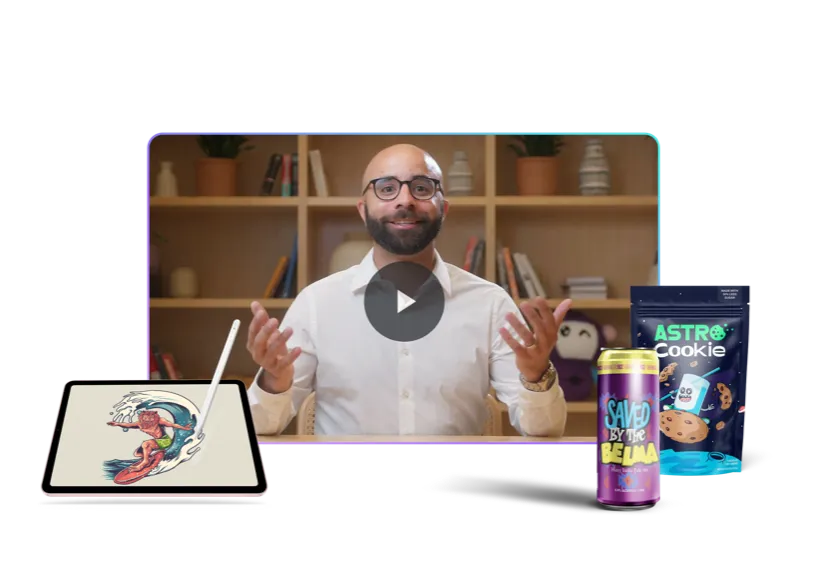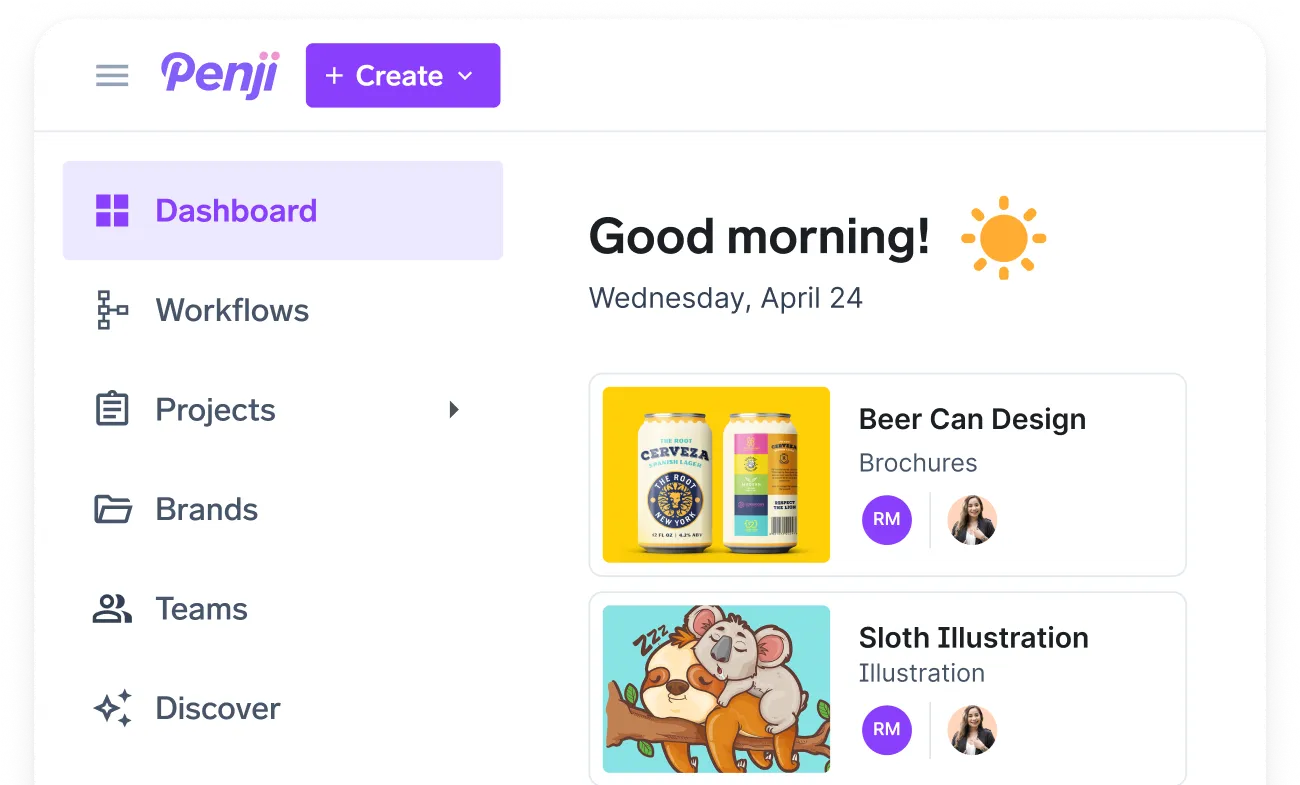![Transcription – [Fully Managed] Gal Borenstein from Borenstein Group, Inc. Ep. 173](https://penji.co/wp-content/uploads/2025/08/BLOG-IMAGE-Gal-Borenstein.jpg)
Daniela: Okay, Gal, sorry. Tell me what is your hot take?
Gal: My hot take is people in America underestimate the power of hummus, which comes from my native country, Israel, where I was born and raised. That’s really kind of what they call fast food. You can eat it with so many things but the traditional is a pita bread you can eat it with a bunch of olives which is Mediterranean and that’s pretty much the diet that now people are trying to reinvent into the Mediterranean diet that’s basically been the diet for hundreds of years so it’s kind of amusing to see all the new places that are being opened claiming that it’s a new phenomenon. It’s not, but it’s good.
Daniela: I have the same experience with avocado. I remember in, I’m Latina, so I’m from El Salvador. And in Latin America, we eat a lot of avocado with our food. Since I was little, avocado has been like a big part of our diet. And for some reason, I remember back in like, 2017, millennials started to like, claim it. I was like oh avocado toast and like adding avocado to a salad and it was like the same thing with hummus like a huge deal and I was like it’s avocado it’s just a fruit.
Gal: Well another point is in the history of cheese for example I know for a fact that the cheese industry in like twenty years ago, tried to figure out how they can increase their sales. So they went to Madison Avenue to an agency, and that’s where it started to have the cheeseburger and adding cheese. So now everything that you eat basically has a lot of cheese, but that’s where it comes from. It’s literally an advertising invention as opposed to something that existed organically.
Daniela: Yeah, I know. I think a lot of trendy foods are very much the product of advertising, which is a great way to get into our podcast.
Podcast Introduction
Daniela: Everybody, you know the drill. My name’s Daniela. I’m your host. I’m Penji’s partnership coordinator. Welcome to Fully Managed. Today, I’m joined with a very special guest, Gal Bornstein from Bornstein Group. And we’re going to have a great conversation today. We talk about marketing, we talk about business, and we help assist you guys in your journeys. So, let’s get started. Hi, Gal. How are you? I’m very excited to have you.
Gal: Hi, Daniela. I’m very excited to share with you my insights and looking forward to the interview.
Daniela: I am too. I am so excited. Guys, you already heard Gal’s hot take, so we know a little bit about him. But to get the ball rolling, get us started a little bit, can you tell us everything that we need to know about you? about Bornstein Group, about marketing, about your books. There’s a lot to talk about. So let’s get a quick intro.
Gal’s Background and Origin Story
Gal: All right. So the short version of my life is that I was born and raised in Israel, and my military service there, which is mandatory, was as a military journalist. So I got to experience being a journalist during kind of wars, which what a CNN reporter would do at age eighteen. And then when I graduated at age twenty one from the military, I looked for a radio, television and film school. And lo and behold, Israel is a small country. It didn’t offer that degree. So I asked my dad, would you be able to help me pay tuition if I found a university in America and come on a foreign student visa? And my dad said, yes, if you go there and come back after six months learning English, that would be terrific. And if it’s of interest to you, that would be even better. And I have exactly enough money for six months. first semester, if you will. So I got on the plane. I landed on January fourth, which was the coldest day in the history of Philadelphia. And it was about twelve inches of snow covering the airport. And I had to wait with a very thin coat and my suitcases as it was snowing as the airport was completely blocked by ice and snow and typically what you do is you basically find a cab well being complete stranger to the country I basically hailed for a cab and the cab says it’s going to be a hundred and fifty dollars to get you to the Western part of Philly where there was an international house for students, which I had the address to. My common sense kicked in and I said, there’s no way it costs a hundred and fifty dollars to go five miles. I mean, I understand the value of transporting somebody through the snow, but still it doesn’t make sense. So I stayed another two and a half hours And then for fifteen dollars, I was able to make my way to the promised land. In that case, it was actually to the house where this international students were being hosted.
Education and Early Career Development
Gal: And then I started my career really at age twenty one, being older than most people to start college at age eighteen. And it gave me a unique opportunity to study at Temple University in the School of Communication. And the major was called RTF, Radio, Television, and Film. A funny anecdote is that when interviewing different students that were taking that program, half of them believed that there won’t be any papers that you have to write because you’re just going to watch movies and film and radio and to this day it amuses me because RTF the name of the major became “Rather Than Fail” and we basically distributed t-shirts with that and that became something that I kept in my mind.
One of the most significant part of who I am really was the principle of nobody gives you knowledge. Nobody basically is born a genius. We are creatures of learning. And I consider myself a perpetual learner. So even in 1992, when I graduated from Temple University, I was probably one of the fifty out of a class of thousands of people that actually knew how to use PageMaker, which is now the layout software that you use on Canva in the new edition. But then editing a layout of a newsletter took because you had to create layout. So I learned how to use creative tools, but most importantly, I was computer literate and most of my friends stayed away from anything that is called a library.
So that set the course for the rest of my career, which was studying about communications, studying how to actually use communications in a good way and in a negative way, how to use and leverage psychology to create influence, and most importantly, how to encode and decode and code again based on customer feedback. And that passion for actually playing a psychologist by creating messages for advertising, marketing, and PR was very exciting to me.
And then it got married with something that at that time was like talking about doing a degree in space cadet type of operation. And I studied and graduated with a minor in telecommunications. So when somebody said you’re studying telecommunication, not even engineers knew what it was then. And that was basically the prehistoric pre browser of the internet. And then a few years later, of course, Netscape and the entire internet generation has begun.
The Techno MBA and Early Job Search
Gal: So from there, I moved to Fairfax, Virginia, because George Mason University was the first university in the country to offer a techno MBA, which was basically saying it’s an MBA, but with a concentration on technology, knowing that the technology economy is going to be huge in the coming years. And taking that knowledge, I graduated only to realize that the only job I was able to get with all this experience of journalism, finishing an honors program, knowing things about telecommunications, which becomes the internet, there were no jobs available. There was a recession. And because I didn’t have a family here, I came on my own. I wasn’t fortunate enough to have those friends that you can connect you with somebody. And there was no LinkedIn to kind of say, hey, maybe you can connect, connect with this person or with this person.
So what’s fascinating about it was that there are no jobs. So when I saw a help wanted ad for a marketing assistant, I took that job and the job paid twenty eight thousand dollars, which is essentially what they paid receptionists at the time. But very quickly in the small company of two hundred people that focused on telecommunication systems at the time, it was the first digital phones, computer telephone integration, which they would call auto attendance and bots and AI bots. I got to kind of learn from scratch how to kind of help engineers who owned the company communicate.
So in the first two weeks, I was a rookie. By the third week, people came to me and say, Gal, we want to do this. We want to communicate with our customers. How do we do this? And I said, let me think about it. And I had a system of taking a sticky note and put it in my cap, the place where I was sitting. And then one day, the vice president and the president of the company were walking through the halls of the main office place where everybody was working, and they see a wall full of sticky notes of different ideas that people came to give me, but most of them, can you do this for me? And they were kind of shocked because their experience has been that they tell somebody to do something, unless it’s an order, it doesn’t get done. And to me, it was exciting to try all these different things.
The Birth of Bornstein Group
Identifying Market Gaps
Gal: So that really kind of gave me the anchor experience that led to the birth, if you will, of the Bornstein Group. And the Bornstein Group was born because I identify three key, very interesting dynamics. One, when I was the marketing assistant, we needed an agency to come and help us. And what we found very quickly by me interviewing the agencies that were coming to pitch were the best, that they would send the president of the agency to the presentation. But as soon as they found out that we’re not spending fifty or a hundred or a quarter or a million dollars or more, they send the most inexperienced junior to the next meeting, which to us was disrespectful because it meant we’re not that important to you.
The second is, I saw that many, many agencies, in fact, all of them did not understand technology with the exception of consumer products, of course. And I said, well, that’s interesting. How come there’s no agency in the Washington DC area where I am that actually specializes in technology and helping technology companies.
And the third was actually, how do you operate when you’re not a large agency? What about all the small technology companies out there that don’t even have a marketing department or marketing communication manager, because it’s not in their DNA. They’re thinking that the most sophisticated technology that they build and they call it R two three five six dash eight, because that’s how coders and programmers and engineers think, which is logical. And they believe that by the merit of their technology, they’ll be successful, only to find out that, no, people need a reason to buy. People need to have a brand they can associate it with. You can’t really sell something if people don’t endear themselves to the product or the service.
Starting with $2,000
Gal: And that really kind of clicked in my head. So I took a two thousand dollar extended a visa check loan, which is basically a loan on your credit card with thirty percent interest that allows you to withdraw up to a certain amount. My credit limit was two thousand because I had no money. That was the funding of the Bornstein Group. Two thousand dollars.
Daniela: Yes. Two thousand dollars on a credit card with a thirty percent interest. That’s like impressive because not a lot of money, also a lot of debt for someone who’s starting from zero. And somehow you’ve grown all of that, right?
Gal: Yes. And really kind of it was a challenge that I took to myself and to say, what does it take to actually build a business? Knowing that one of the secrets was that I never even sold at a lemonade stand. So I learned how to sell and develop business by listening to tapes as I was going to pitches and learning from the best of the sales masters, like books on tape, and learned what’s important and what’s not. And probably the single most important thing that I learned from all these audio tapes was “you are the sale.” And which meant when you go in and you sell whatever it is, or you develop business, you are the sale. So if you, if people don’t trust you, people don’t believe in you, it doesn’t matter what the name of the company is. And it looked reasonable, but making it and manifesting it into reality required looking like the part and being the part and living the part.
The Strategic Naming Decision
Gal: So one of the most amusing memories was I started an agency with one employee, which was me. So how do you basically what do you call a company? Well, it could have been Gal Bornstein Communications. It could have been Bornstein Communications. But I thought in my head, well, what happens if somebody’s thinking, we want to work with this agency, but it sounds like they have only one employee. So I called the company, the Bornstein Group. The Bornstein Group meant there’s obviously more than one. And it took on very quickly.
Daniela: You became an actual group leader. Yes. Like my kids always say, you know, get your own group.
Early Success and Strategic Positioning
Gal: So what happened, essentially, the Bornstein Group immediately gave me credibility to go into places and network with people, with CEOs of companies. And they never really asked that question, how many people work for you? And in fact, most people believed that I am the spoiled kid of the legacy agency owner. And I’m basically there’s a dad or there’s a old money behind me. And I’m just a kid, because I was at that time.
Daniela: So super young, yeah.
Gal: Yeah. Super young, but very ambitious and not taking no for an answer. And probably the most important thing was, operating under the mantra really, or motto that no one’s really smarter than you or better than you. I think people are just more experienced. I would say you can get the experience to have the same skill level that someone else has. And you can learn the things that they already know, but because you’re starting to learn a little ahead of the curve, that really gives you an opportunity to get ahead in the game and really create something that is unique.
Because I knew a lot about every technology that was around because of my techno MBA, there was no match when I was going into a presentation and another agency was coming and saying, well, it’s all about the colors and it’s all about being purple or being red, and here’s a smart tagline. And I would come in and say, what is your marketing strategy? Why are you interested in even working with an agency on your PR, on your marketing, on your branding?
And what I found very often is that the lonely child, if you will, of this industry is marketing strategy, which required an understanding of how do you build a business plan, not the whole business plan, not the financials, but the why, the what, and the where and when in order to be successful with whatever it is that you’re doing. Interviewing their customers, and benchmarking what they see as the most important thing about the company, and then marrying it to what the management that wanted to produce a campaign was thinking. And by literally learning how to match the behaviors of different organizations with their customers, with their employees, and aligning it with executive management, that really kind of what helped Bornstein Group become a name that very quickly became synonymous with strategic marketing.
But under the umbrella, strategic marketing for some people sounded like a kind of a scientist sitting in an office or a nerd that doesn’t understand and not creative enough. So I changed my business card that said at the beginning, marketing communications, or integrated marketing communications to be exact, to marketing, branding and PR. And suddenly, the flood gates open. And it was amazing to see how many people suddenly understand what we do.
So that really is the short version, if you will, of how the agency started. Fast forward, twenty eight years later, The Bornstein Group is one of the only agencies that I know of that are privately held that have been in business for that long and sustained the same audience, which is business to business. And till today, we are working with executive management with chief marketing officers, with directors of marketing, and a lot of CEOs of very, very smart technology companies that need more than just creativity. They need a business objective that connected to produce repeatable and predictable outcomes.
Gal’s Published Books
Daniela: So you have also written some books I know you just came out with a book in November of this past year called “Don’t Believe the Hype” you have also had other books called I believe one is called “Activate” and the other book “What Really Counts for CEOs” yeah I read all about you know like what the books were about I was kind of curious because you are also the type of person that has been in the industry long enough to know a lot about how to be a CEO how to be an owner of a business how to scale and just in general how marketing is working nowadays which I think marketing is interesting because it’s such a mix of creativity with data. Marketing depends a lot on data, but at the same time, you have to be very creative. And what I’m mostly interested about is how did you decide or what drove you to decide to kind of put your knowledge into these books and sort of spread that around was it all the experience that you had over the years and then you were like I need to put this somewhere were people asking for it how has that experience been for you?
The Motivation Behind Writing
Gal: So as I kind of start kind of creating training for my employees and interfacing with a lot of CEOs, I realized that most of them have counter-dynamics, and the counter-dynamics puts them in one camp or another, but they still don’t understand how marketing and branding and PR work together in concert to promote their cause.
So my first book, “What Really Counts for a CEO?”, was simply taking all the interviews at work that I had and asking CEOs, well, if the marketing campaign worked, what does success look like? Another adage that was very true is in many companies, even today, marketing and sales hate each other. The sales people in the organization think that the marketing people are just sitting and doing nothing or do not produce anything that is important. And then, of course, the marketing folks in the company, even at the smallest or the large companies, have contempt for the salespeople because they always ruined a theory or a measurement or campaign or didn’t follow up with the prospects. It used to be by phone now it’s email now it’s bots it’s really interesting but it’s amazing it was taking those interviews and they said well if you were a CEO and you had a sales department and marketing department in the agency what are you thinking so I wrote it through the eyes of a CEO but also helped it understand essentially what is important for them to know about their own people and the professionals they’re working with that they should be watching out for and how to basically be successful.
“Activate” – Digital Branding Book
Gal: The second book very quickly was “Activate”, which was all about ushering the digital branding age and understanding that a website can no longer be an online brochure, which it used to be, to understand the intricacies of using data analytics to create more than just a theory of success, but actually make sure that it’s proven and can be trusted, and most importantly, can be replicated to produce repeatable and predictable outcomes, which is the Webster definition of science. So creatives do experiments. Scientists create something that you can use again and again and again and again. And that’s what constitutes success.
“Don’t Believe the Hype” – Latest Book
Gal: I have with me my latest book, “Don’t Believe the Hype”. And actually, this book is about seeing what happened to the world when everything became digital and especially with social media in the glass store and all these tools that can ruin your brand or can make it successful.
Daniela: Yeah reviews online social media.
Gal: Yes and you know the most common example that I use really is Amazon is a great company right But if you’re going on Amazon and you had to buy a product of your choice, how would you make a decision? It wasn’t advertising. So if you knew about the product, name ID you would basically think oh that’s the product I know and the other guys are called XYZ I don’t know what it does so I’m not going to buy from them right Amazon changed the system to reviews real people actually putting reviews about what they’re experiencing so if you saw a product that had five stars but eight reviews versus a non-product that had a thousand reviews and there was three and a half, you would make a decision based on what are you able to trust. And that basically anchored the book to talking about what is digital trust and how you can measure it.
So between fake reviews and real reviews and data analytics and social media, and most importantly now with social media influencers that are getting actually paid but they look like they’re authentic influencers that are basically really talking from the heart. Well, there might be a few of them, but if you think about Kardashians, if you think about the kind of the pioneers of the influencing industry, now you can rent an influencer to talk about your product.
So the book really is called, “Don’t Believe the Hype” Because digital trust is coinage that is really hard to understand unless you took into consideration all the challenges and understand what’s real and what’s not. So my message to all professionals whether you’re buying something or you’re a CEO or a chief marketing officer that develops your brand, is you can’t believe one thing. And you certainly can’t believe just because analytics show that a lot of people visited your site or a lot of people responded to your CRM marketing campaign or you got published an article in the Washington Post or New York Times. Now you made it. It doesn’t work that way. You really have to understand the consumer behavior, the business strategy, and connect the dots to what are the tools and methodologies that will allow you to be successful. And that’s really kind of what this book is about, is to say, don’t trust anything. You can test everything, but you have to trust but verify at the end of the day in order to be successful in marketing, branding, and PR, which now is merged with social media.
The Impact of Social Media on Marketing
Daniela: Social media has really come to change the game. I think we can all agree. The internet in general marketing has really influenced marketing has really sort of brought digital marketing to a kind of, I guess, popular state. I think digital marketing used to be popular, but not as much. And it was definitely handled differently. Even when internet had already started, I think it’s just social media specifically really changed how digital marketing, was handled. And we see a lot of brands kind of tapping into that in the coming years. And now it’s like every brand has to be doing some form of social media marketing, even if it’s minimal. Just having social media presence has become a priority for most branding. So I can totally agree with how much that has changed and how the public’s perception of brands, products, services has changed due to all of that. So it totally makes sense.
The Messenger Problem
Gal: Yes. And really kind of what has changed also is who’s the messenger, not just what the message is. And the biggest places where we actually start seeing it in the marketing world, start paying attention to when Facebook became kind of the main platform a few years ago for exchange of opinions, only to find out that the Russians and the Chinese were able to create American personas and put political campaigns that looked like they were coming from Americans. And that basically opened the eyes of all social media organizations, including Twitter and Instagram and all these different places were putting information. And that’s the question is, you know, am I watching something real?
Fast forward to the fake and avatars that you can program that shows a person actually selling you the product. And they’re smiling. They’re using the terms. They’re very convincing. And people don’t know that it’s a digital avatar that doesn’t have feelings or doesn’t really have any connection to reality. But that becomes the reality for the people that are watching it and it increases engagement. And that basically a ball that rolls all the way to market.
The Rise of Conscious Consumers
Daniela: I think what you are sharing is really important because I think also, whilst the public doesn’t understand fully how marketing is, I do think we are seeing a more educated audience, especially with younger generations. They’re a little bit more savvy on marketing because it’s so much more present and I think a lot more shameless about it being marketing. I think marketing tactics were a little bit more hidden or not as obvious before. And we had an audience that was a lot less conscious or didn’t care so much. I think with the younger generations, you see that being sort of a shift towards a more conscious audience. And then they’re demanding kind of like disclosing that you are being marketed to what the monetary gain is for who is being promoted, there’s just disbelief in general. So I think that’s also going to be something that’s going to be changing the digital world in the coming years.
Democracy of Information and Generational Insights
Gal: Absolutely. And it comes back to what I said about digital trust is people have now more of a democracy, if you will. Anybody can go on TikTok and put a video with their opinion. And if people like it, it becomes kind of a following and the following becomes a bigger sharing community of knowledge about what works what doesn’t work and whatever opinions are being promoted but still at the end of the day would as the generations basically go from Generation X to Generation Y the millennials and now the Gen Zs. I have three adult sons that graduated recently from colleges working in the workforce. And they’re actually my best focus group for anything that we do at the Bornstein Group because they, as you described, are very fickle about trusting anything. And at the same time, they show me what works and what doesn’t.
So in a way, I take what I know, but I also listen to what a new generation of consumers is considering effective. And what happened, what worked yesterday will not work anymore. And you got to be agile and being able to use multi channel approach. So it’s none of the above or some of the above, or you know, creating a whole new concept, how to communicate. And I think that’s a very exciting age to be in marketing to be in PR, to be in social media for anybody who’s creative and seeks to influence people through the techniques that we described.
Daniela: Yeah, I think that’s, I mean, it’s very interesting and I want to urge all of our audience to purchase your book, to go and check out your website. Guys, if anything that we have spoken about has resonated with you, Gal, I want you to tell us where we can find you, where we can purchase your books. The moment is yours to tell us what we can do to work with you.
How to Connect with Gal Bornstein
Gal: Well, I think if you are a like-minded person, a professional that is looking to further your career, I think you should go on LinkedIn, find my name, go to Bornstein. And I’m very happy to connect with the younger people that are starting and help them or mentor them into the right direction. Some wind up being internships, from places that I couldn’t have imagined. I’m in Washington DC and somebody in Kentucky or Arizona or even overseas become a friend as a result of a connection on LinkedIn, as long as they are intending to actually learn versus to sell you something with it, which is very different.
All my books, including my latest, “Don’t Believe the Hype”, are on Amazon.com. You can just type in Bornstein Books and you will find them. And our website is BornsteinGroup.com. And on our website, you will find a lot of thought leadership information articles that are very interesting because they really kind of expand the knowledge base of how do you do things how do you attract leads how do you create a brand how do you rebrand a company with thirty three thousand employees that had come from six different companies with six different cultures. All these different things, we tried to basically analyze it, the company, and promote it in a thought leadership article and creating handbooks, seminars, workshops, anything that can help clients and people that want to be clients, prospects, to choose the right agency, which I believe is the Bornstein Group.
Closing Thoughts
Daniela: Awesome. Yeah, I will be adding the links to that on the description, like I said. So everybody go and click on those links. Guys, subscribe to our channel. Thank you so much, Gal, for being here today. I think you have such a great career and you’re so knowledgeable. So it’s great to hear from people like you who are always very experienced, who know a lot about marketing, who have been in the business for so long. Your perspective is also always very, very interesting and very, very educational for us who are young and learning about this. So thank you so much, Gal, for being here.
Gal: Yes, I just wanted to add that there’s no such thing as old or young anymore. It’s being a perpetual learner and listen to more than the echo chamber that you’re in and whatever echo chamber you’re in to learn. And as long as you are open to learning, the latest and greatest thing that you may not know how to do yet will come to fruition. And I think that’s what I wanted to take out of this.
Daniela: That’s a great message to end the podcast on. Thank you so much for being on the show today. I am so happy that you came, Gal. And everybody, I will see you guys on the next episode.
Gal: Thank you, Daniela. Thank you. Have a great day.









